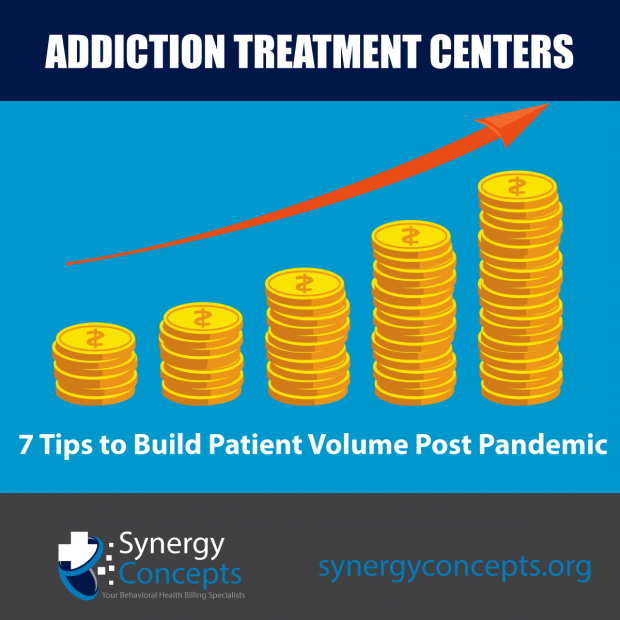Behavioral health facilities have been through more than anyone could have ever expected in the last few years. Because of the coronavirus spreading like wildfire through the population, many people have stopped or paused going to get addiction treatment. This is a problem for rehab clinics and treatment centers due to the decrease in revenue. This could cause delays in treatment or even closure of your facility. What you need to do is increase patient volume. But how?
The CDC and other public health authorities warned individuals against gathering in small, crowded, unventilated spaces. For many people, this includes waiting rooms.
Patients are canceling appointments and postponing non-emergency tests and procedures to avoid exposure to infection from COVID-19. Their goal was to wait until they get the vaccine, before venturing out again.
Behavioral health facilities and addiction treatment centers are experiencing a dramatic reduction in patient traffic due to COVID-19.
You can increase patient volume and re-engage with your patients in 2021 but it requires a proactive approach to boosting visits and care.
Seven tips to increase patient volume:
- Telehealth Sessions
- Reopen in Phases
- Reach Out to Previous Patients
- Reassure Patients of Your Enhanced Safety Precautions
- Enable Quick and Safe Patient Appointments
- Prepare Your Staff
- Reach Your Patients Through Social Media
Offer Telehealth Sessions to Increase Patient Volume
 Many treatment centers are responding to the pandemic by offering virtual appointments through telehealth sessions. If you haven’t made this option available yet, now would be a good time to start. Patients are able to communicate with doctors through video conference services, like or voice calls.
Many treatment centers are responding to the pandemic by offering virtual appointments through telehealth sessions. If you haven’t made this option available yet, now would be a good time to start. Patients are able to communicate with doctors through video conference services, like or voice calls.
Once you have this option available, you should tell patients about this option through email, your newsletter, your website, and social channels. You can even place a QR code with your contact information on posters in your reception area.
Reopen in Phases
 Reopening your doors with a strategy is best when there is so much uncertainty about when the pandemic will finally be behind us. You will do well if you open up your practice gradually, in phases. You can plan with your staff over a 4-8 week time frame, allowing a gradual increase of patients. Make sure to require masks to keep your staff and your patients safe.
Reopening your doors with a strategy is best when there is so much uncertainty about when the pandemic will finally be behind us. You will do well if you open up your practice gradually, in phases. You can plan with your staff over a 4-8 week time frame, allowing a gradual increase of patients. Make sure to require masks to keep your staff and your patients safe.
A good starting number for appointments for the first week would be 25% to 50% of patient appointments, depending on how big your clinic is. This will allow your staff to readjust at a mentally healthy pace, and your patients will feel safe.
Reach Out to Your Patients Who Canceled Appointments Because of COVID-19
 Go through your records and find the patients who were no-shows or who were canceling appointments during the COVID-19 spread. Connect with these patients and reassure them of your safety precautions in response to the COVID-19 pandemic. They may have canceled their appointment, but they still need you as much as you need them.
Go through your records and find the patients who were no-shows or who were canceling appointments during the COVID-19 spread. Connect with these patients and reassure them of your safety precautions in response to the COVID-19 pandemic. They may have canceled their appointment, but they still need you as much as you need them.
Explain that you are opening your doors and will be offering full hours again, soon. Emphasize that you are reaching out to remind them about the importance of following up on canceled appointments and that you are here to help them succeed with their treatment.
Connect With Patients About Your Enhanced Safety Precautions
 You need to explain your health and safety protocols to your patients. Clear explanations of the rules reassure people who are concerned about exposure to COVID-19. Also remind patients about the requirement to wear masks when visiting your office.
You need to explain your health and safety protocols to your patients. Clear explanations of the rules reassure people who are concerned about exposure to COVID-19. Also remind patients about the requirement to wear masks when visiting your office.
Get organized before you connect with patients. At the top of your list should be the calls to patients who have appointments already scheduled. Take the time necessary to reach out to these patients. Once you’ve finished your scheduled patients’ list, connect with patients who have skipped visits.
Concerned patients will be happy to know that your office requires patients and employees to wear masks. Remind them that health care providers have their safety in mind when they wear gloves.
Patients care about the smallest details, including seeing your staff washing their hands between appointments and regularly cleansing the office public areas. Assure them that you follow best practices for their safety and yours.
Enable Patients to Get Appointments as Soon as Possible, Safely
 Patients are now feeling secure and safe enough to go out into the world again. They are making appointments and you want them to schedule as soon as possible.
Patients are now feeling secure and safe enough to go out into the world again. They are making appointments and you want them to schedule as soon as possible.
One approach is to stay open later at least one day per week. If you have the resources and staff, consider offering patients the option of weekend appointments. Weekends are easier for many patients not wanting or unable to take any more days or time away from work.
To safeguard patients, offer new ways to wait for their appointment or to engage with staff, like telehealth. You will need to limit the number of patients who can be in the facility’s public areas at the same time. Social distancing in this case can extend to the parking lot. When a patient arrives, have them text or call before they come in. If a patient is just dropping something off, such as a urine sample or paperwork, a staff member can just meet the patient at their car to pick it up.
Prepare the Front Office Staff
Your staff could face a much larger patient volume than you expect. Hold a meeting to prepare them for this.
Reinforce the value of connecting with patients. Your patients need to feel relaxed and safe as they venture into your clinics.
The more your staff engages with patients, the more loyalty you can cultivate from them. Discuss ways your staff can be extra compassionate. Patients are under enormous stress, worrying about their health and the safety of their loved ones.
Remember that some patients have been impacted financially due to company closures during the pandemic. That only adds to the stress and anxiety surrounding COVID-19. Patients feeling emotionally wrung out will need sympathy and a kind ear when they connect with your staff.
Do not let your staff grow complacent after enduring the pandemic shutdowns. No one can predict the future and you may have to go through another shutdown if there is a new outbreak nearby. For best results, make contingency plans for how you will respond if coronavirus infections start increasing again in your local community.
Be Active on Social Media to Reach and Communicate with Patients
Most people have at least one social media account, which includes your patients. Make sure you are active on the accounts your patients use in order to answer questions and even schedule appointments. This will also help you reach more patients who would otherwise not know you exist.
Communication in all forms builds trust with your patients and trust is important with health and safety concerns.
Increase Your Patient Volume
Increasing patient volume to the level it was before COVID-19 is going to be a high priority for your behavioral health clinics or rehab facilities in 2021. Doing so will be crucial for maintaining financial stability and making sure your facility is ready for a post COVID-19 world.
As you work to boost patient volume this year, you’ll want to familiarize yourself with the latest in revenue cycle management and medical billing and coding. Now’s a good time to ask questions about your current revenue cycle management provider to see how they are helping you grow and stay financially stable.
Have questions about revenue cycle management and behavioral health medical billing and coding? Contact us today.









Leave a Reply